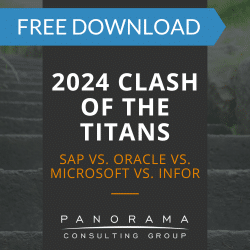You can’t rush into an implementation. Before implementing your new ERP system, it’s important to take the time to prepare. This is where the ERP pre-implementation stage comes in.
Positioned between the ERP selection and project design stages, pre-implementation phase activities ensure clarity and alignment throughout implementation.
Read on for a comprehensive guide that breaks down examples of pre-implementation phase activities and best practices that can set the stage for a successful ERP journey.
What is Pre-implementation?
During pre-implementation, you’ll focus on activities that help ensure a smooth implementation and go-live. A few of the most important pre-implementation activities and tasks in ERP include:
- Ensuring you have enough resources allocated to the project
- Ensuring everyone on your team agrees on the project scope
- Ensuring there is no confusion on business requirements
After you complete these steps in the pre-implementation phase, your ERP project team will launch straight into the design phase where you will determine the exact functionality of your system. That’s why it’s important to get everyone on the same page before moving forward from the pre-implementation stage.
The Beginner’s Guide to Digital Transformation
What are the 6 secrets to digital transformation that are helping organizations build competitive advantage?
8 Pre-implementation Stage Activities and Examples
1. Build a Project Team
Your ERP project will be comprised of a number of pre-defined tasks, each carrying its own schedules and dependencies. That said, it’s important to build a team that can help oversee or perform these tasks and work together to keep the project on track.
When building your team, look for employees from across departments with subject matter expertise. Similarly, when choosing a project manager, look for someone who is intimately familiar with your business, has proven project management skills and can work well with a variety of personalities.
2. Define a Resource Strategy and Backfill Strategy
Many companies struggle to understand the resources required to implement an ERP system. This is often because their ERP vendor fails to set realistic expectations.
The truth is your company will likely be responsible for a number of important project activities, such as change management and data migration, which may or may not be included in the vendor’s project plan.
Ensuring adequate resources requires open communication with your vendor as well as an understanding of implementation best practices and the importance of change management.
In addition to a resource strategy, you will need backfill strategy. With so many of your A-Team members hard at work on your ERP project, how will your company continue to operate and grow? While it can be difficult to pull prominent team members away from their day-to-day duties, you can always employ a backfill strategy. This ensures you have resources to take over or help support these roles so project team members can focus on the ERP project.

3. Define and Execute a Data Strategy
Your data strategy includes the steps you will take to migrate your business information from legacy systems onto your new ERP platform. To do this successfully, you will need to define clear data conversion and data reconciliation processes. You will also need to assign data owners and delegate responsibilities.
The first step of ERP data migration is analyzing the status of your current data. Then, you should consider the technical data conversion resources you’ll need to move information from one storage location to another.
During this process, it’s important to ensure that any non-systematic data you carry over is clean of redundancies, inaccuracies and duplicities. At the same time, the new data you enter should be accurate, consistent, complete and valid.
Rather than migrating everything at once, remember to work systematically to mitigate the opportunity for error.
4. Set up Infrastructure and System Environments
This is where you determine the specific system infrastructure in which you plan to run your ERP solution. The two most prominent options are on-premise ERP and cloud ERP.
As there isn’t a one-size-fits-all answer, you’ll need to take into account your unique business requirements, budget and long-term goals to determine the infrastructure that works best for your company.
Then, consider the number of system environments necessary. Do you need a sandbox testing environment? What about one for end-user training? How often will these environments be refreshed and who has access to them?
5. Establish Project Charter
An ERP project charter is a short document that describes the most important aspects of your project. Some of the key details to include are:
- Your project goals
- Steps you will take to achieve these goals
- Your key stakeholders
- All identified risks
- A general budget overview
This document can serve as a resource to go back to if you feel your project veering off course.

6. Educate Executives to Ensure Continued Buy-in
To ensure that your executives continue to provide much-needed support, we recommend estimating the projected ERP business benefits. How much money will the system save the company? Will you improve a key performance indicator (KPI) by a certain percent?
These stakeholders are investing a significant amount of money in your efforts. Creating a benefits realization plan can help them visually understand the value and ROI. An ERP consulting firm can help you quantify potential cost savings and other tangible benefits of ERP.
7. Focus on Change Management
There’s no denying that ERP projects can be disconcerting to employees, especially to those who haven’t been involved in the effort since its inception. To this end, you might experience a little pushback when you prepare to roll out your new ERP solution.
To help quell any anxiety, it’s important to ensure project awareness. In other words, define any role changes that are required and communicate as frequently as possible. You should also be available to answer questions as they arise.
These activities should be part of a comprehensive organizational change management plan that transitions employees, manages resistance and helps everyone in the company embrace change.
8. Standardize and Streamline Business Processes
Any time you deploy a new business technology, it’s helpful to give your current business processes a second look. Where can you standardize and streamline to increase efficiency?
While it’s easy to get carried away and want to overhaul everything, keep in mind that ERP customization can be an expensive and laborious process. That said, we recommend keeping the out-of-the box functionality of your ERP software top of mind so you can ensure the system is capable of handling your requests with minimal adjustments.
In other words, any business process reengineering you do should heavily focus on standardization and adopting the best practices within the ERP system.
Don’t Overlook the Pre-implementation Stage of Your ERP Project
A pre-implementation plan gives you the opportunity to ensure adequate resources, align stakeholders and help employees embrace change. Request a free consultation below to discuss your unique project challenges.














